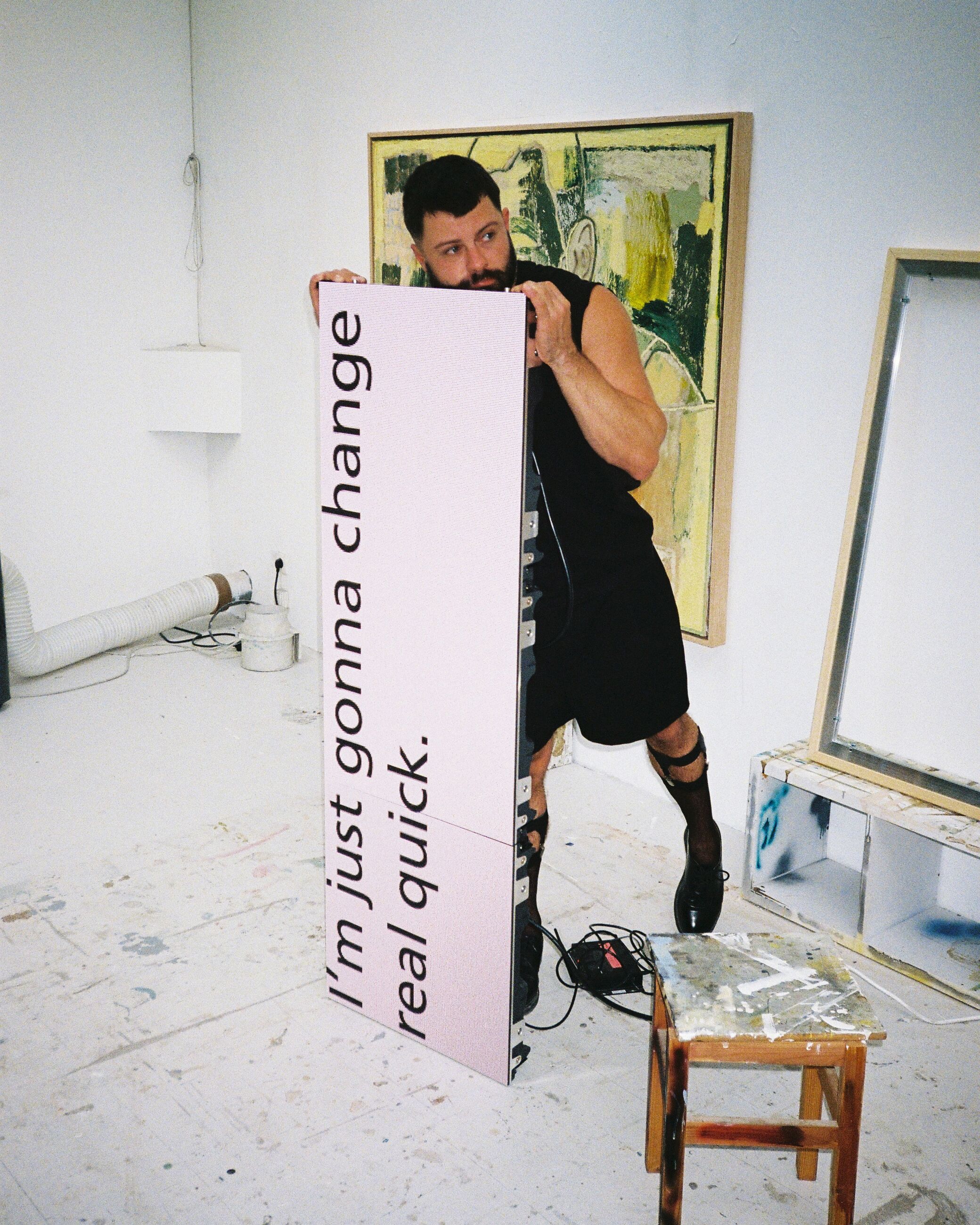The Third Edition of Hauser & Wirth Invite(s) in Paris with Philipp Timischl

The Third Edition of Hauser & Wirth Invite(s) in Paris with Philipp Timischl
For his exhibition at Hauser & Wirth Paris, Philipp Timischl sets a stage for artworks that continue his exploration of how images behave, speak, and sometimes fail to perform. His practice brings together painting, video, and text, often within a single work. Canvases are extended with LED screens that display looping clips and subtitled thoughts, turning the painting into a kind of narrator or unreliable companion.
Some works are more mute, including a group of broken raccoon paintings framed in ornate mouldings and washed in indifferent grey. A low-cost toner print replaces the image we might expect to see. The gesture feels half-hearted, even wounded. These works borrow the language of grandeur only to deflate it. It’s a kind of class drag, cosplaying the salon painting while exposing its market logic.
Timischl treats the artwork less as a container for content than as a set of behaviors: hesitant, disjointed, at times indifferent. There’s something theatrical in the way these pieces are staged. Each one holds a pose, adopts a voice, or chooses silence. They test what happens when aesthetic value, identity, or emotional tone are suggested, then withdrawn or misaligned. Sometimes this produces a kind of awkwardness, other times a quiet kind of comedy.
—Sabrina Tarasoff


About Hauser & Wirth Invite(s)
Hauser & Wirth Invite(s) reflects Hauser & Wirth’s longstanding commitment to building a sense of connection in the places where it works, collaborating with artists early in their careers, galleries of different scale and writers addressing new audiences, all in support of a sustainable art ecosystem. By hosting fellow artists, galleries and writers in our spaces, we offer wider visibility of their work and ideas to engage with the vibrant creative community.
About Philipp Timischl
Philipp Timischl (b. 1989) grew up in the rural countryside of Austria and now lives and works in Paris, France. His practice spans video, sculpture, painting, and photography, often combined with text and culminating in site-specific installations. His work frequently engages with power dynamics—particularly regarding social class, queerness, heritage, and the art world. After studying at the Städelschule in Frankfurt and graduating from the Academy of Fine Arts Vienna, he has presented solo exhibitions at the Museum of Contemporary Art Belgrade (2025), Le Confort Moderne, Poitiers (2024), High Art, Paris (2024), MGK Siegen (2023), Layr, Vienna (2023), Heidelberger Kunstverein (2022), Secession, Vienna (2018), and Halle für Kunst Lüneburg (2016).
His work has been shown at the NGV Triennial, Melbourne (2023), the Lyon Biennale (2022), and in group exhibitions at Marta Herford / Kunsthalle Bielefeld (2024), Belvedere 21 (2021, 2019), Kunsthalle Bern (2019), Kunstwerke Berlin (2016), Luma Foundation Zürich, Sandretto Re Rebaudengo Turin, and Serpentine Gallery London, among others. Public collections include mumok, Belvedere, Kunsthaus Bregenz, Heidi Horten Collection, and EVN Collection (Austria); Saatchi Collection (London); FRAC Corsica; and the National Gallery of Victoria, Australia.
About Layr
Founded by Emanuel Layr in Vienna in 2011, Layr focuses on conceptual practices that engage with contemporary social, political, and cultural issues. Based in a city historically positioned between East and West, the gallery fosters dialogue across generations and diverse contexts. Layr represents the estates of Stano Filko and Anna Andreeva, and artists Anna-Sophie Berger, Julien Bismuth, Plamen Dejanoff, Marius Engh, Cécile B. Evans, Gaylen Gerber, Lena Henke, Benjamin Hirte, Lisa Holzer, Tillman Kaiser, Dominique Knowles, Niklas Lichti, Birgit Megerle, Matthias Noggler, Nick Oberthaler, Evelyn Plaschg, Lili Reynaud-Dewar, Josef Strau, Philipp Timischl, and Leah Ke Yi Zheng.
About Sabrina Tarasoff
Sabrina Tarasoff (b. 1991) is a Finnish writer and critic currently based in Cambridge, USA. Her work has been published across publications such as Mousse Magazine, Los Angeles Review of Books, X-TRA Contemporary Art Journal, Sucksess Magazine and Octopusnotes. Tarasoff’s writings, revolving literary theory, pop culture, and visual arts, have also recently appeared in catalogues and books by Inventory Press, American Art Catalogues, and Semiotext(e). She is the editor of the first anthology of late poet Bob Flanagan’s collected writings, "Fun To Be Dead: The Poems of Bob Flanagan," published by Kristina Kite Gallery and Pep Talk. Tarasoff is currently working on a PhD in Comparative Literature at Harvard University on theme park attractions.


Related News
1 / 5




